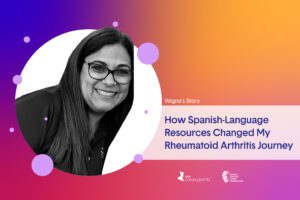If you have a rheumatic or musculoskeletal disease (or are a caregiver for a loved one with these conditions) being engaged in your care means staying up to date on research about your condition. That’s where the annual meeting of the American College of Rheumatology comes in: Every fall, rheumatology health professionals from around the world gather to share best clinical practices and cutting-edge research.
Because of the COVID-19 pandemic, this year’s meeting, called ACR Convergence 2021, was held virtually, as it was last year. Still, our goal remained the same: To ensure our patient community stayed informed about the key learnings and trends from ACR, so they can advocate for better care.
This year, our task was more Herculean than ever. That’s because the weeklong meeting has become about so much more than scientific updates about disease prevention, diagnosis, and treatment. It is also beginning to tackle the contextual, environmental, and systemic issues in our health care and society — from systemic racism to climate change — that must be acknowledged in order to provide equitable, quality care.
“I think COVID-19, long COVID, and civil unrest has pushed scientists and rheumatologists in a new direction that would not have been their path otherwise,” says patient advocate Jennifer Walker, who reported on the conference for CreakyJoints, along with fellow advocates Eileen Davidson, Charis Hill, and Dawn Gibson. The seeds of something new were present at ACR, but we don’t know what the result will be just yet.”
What we do know is that it’s become increasingly clear that you can’t reduce pain, inflammation, and disease activity; treat comorbidities; and help patients improve function and quality of life without looking at the entirety of who they are as a person and how the environment in which they live, work, and receive health care affects their outcomes.
“The virtual platform proved that the accessibility long sought by the disability community is doable,” says patient advocate Dawn Gibson. “We engaged with some of the thorniest issues facing our society, the role that racial and ethno-linguistic factors play in health outcomes. Rheumatology soldiered on throughout the pandemic, and patients continued to make themselves heard, through Patient Perspectives posters, profesional panels, and social media.”
The conference’s opening session set the tone — optimistic, but committed to major change — by featuring an interview with Seema Yasmin, MD, a medical doctor and journalist who is currently the Director of the Stanford Health Communication Initiative. Dr. Yasmin, who has committed her career to improving health literacy to stop the spread of medical misinformation, emphasized the importance of not going back to status quo “after” the COVID-19 pandemic, especially when it comes to radical shifts in medicine that increase accessibility for patients, such as telemedicine.
Dr. Yasmin concluded by saying that “the most frequently used medical procedure is communication” — and we at CreakyJoints and the Global Healthy Living Foundation couldn’t agree more.
With that in mind, here is a crash course in the main highlights from ACR Convergence 2021.
Here is a table of contents to the sections in this resource:
- Axial Spondyloarthritis
- Gout
- Lupus
- Osteoarthritis
- Psoriatic Arthritis
- Rheumatoid Arthritis
- COVID-19
- COVID-19 Vaccine
- Health Disparities
- Mental Health
- Diet & Exercise
- Fibromyalgia
- Integrative Approaches to Pain Management
- Supporting Patients at Work
- Family Planning & Pregnancy
- Pollution and Climate Change
- Patient Perspectives
Axial Spondyloarthritis (axSpA)
ACR shared plenty of data and insights on many of the unique issues faced by patients living with axSpA, including high rates of unemployment, depression, anxiety, and other comorbidities. Other research revealed important data on managing disease flares and preventing disease progression.
Perhaps not surprisingly, an area that got a lot of attention at ACR was the challenge of diagnosing axSPA — specifically, the lack of axSpA awareness among primary care physicians (83% rarely or never order a test for HLA-B27, a genetic marker associated with axSpA) and difficulty interpreting X-rays (could artificial intelligence help?).
For more details on all of this and more, check out our guide: ACR 2021: 9 New Things to Know About Axial Spondyloarthritis.
Gout
Researchers talked a lot about the impact of uric acid-lowering drugs — including the differences between allopurinol and febuxostat, the effectiveness of pegloticase, and treat-to-target strategies to reduce the risk of cardiovascular disease and minimize flares.
Several studies emphasized the importance of managing gout as a chronic disease — for example, by looking beyond just treating the symptoms — as well as the role of diet (specifically omega-3 fatty acids) in reducing flares.
There were also some interesting posters presented this year that addressed patient-focused concerns like the burden of flares and stigma of gout.
For more details on all of this and more, check out our guide: ACR 2021: 7 New Things to Know About Gout.
Lupus
Lupus flares – including what makes them worse and whether stopping or reducing medication in remission can increase your risk – was the theme of several studies at ACR this year.
Perhaps some of the most important lupus research involved identifying disparities in age, sex, race, and ethnicity in patient with lupus, specifically looking at patients’ risk of mortality and multimorbidities (two or more comorbidities).
And we can’t forget to mention the spotlight on lupus during the meeting’s Great Debate, which this year focused how to treat patients with lupus nephritis: Should you use belimumab or voclosporin?
For more details on all of this and more, check out our guide: ACR 2021: 10 New Things to Know About Lupus.
Osteoarthritis
Osteoarthritis (OA) research this year included several studies that explored different aspects of pain management for patients with OA. For example, one study examined whether improving pain via joint replacement surgery could improve mental health; another took a close look at the pain-relieving effects of cannabidiol (CBD) for hand OA.
Additional data and insights were presented about the importance of non-drug therapies, like physical therapy and stair climbing, for disease management and long-term health.
For more details on all of this and more, check out our guide: ACR 2021: 8 New Things to Know About Osteoarthritis.
Psoriatic Arthritis
We learned about new PsA therapies as well as disease causes and symptom management. Among the hot topics: A new type of oral therapy (TYK2 inhibitors), the benefits of IL-23 inhibitor biologis, the importance of treating patients early in the course of the disease, and spinal (“axial”) involvement in PsA.
Other exciting areas of research at ACR included new insights on predicting which psoriasis patients will develop psoriatic arthritis, including whether the microbiome can provide key clues.
There were also several patient-centered studies that examined the impact of PsA on your mental health, relationships, and work.
For more details on all of this and more, check out our guide: ACR 2021: 11 New Things to Know About Psoriatic Arthritis.
Rheumatoid Arthritis
Options in rheumatoid arthritis (RA) treatment, side effects of steroids and methotrexate, and preventing comorbidities, were big topics at ACR this year. One study even looked at whether the biologic abatacept has the potential to reverse early-stage RA.
Patients’ preferences were also front and center, with one study examining the unique mix of concerns and needs doctors should address with patients prior to starting or changing treatment.
For patient advocate Jennifer Walker, the emphasis on research in comorbidities — we learned a lot about lung disease, heart disease, diabetes, and dementia — stood out from this year’s conference. “When a patient has comorbidities on top of their inflammatory arthritis it exponentially complicates their care and requires their doctors to communicate with one another.”
While it was alarming to hear about the many health issues that could crop up alongside RA, it was also encouraging to learn about the research being done to help screen, prevent, and treat them.
For more details on all of this and more, check out our guide: ACR 2021: 11 New Things to Know About Rheumatoid Arthritis.
COVID-19
How does having a rheumatic disease or taking immunosuppressant medication affect your risk for contracting COVID-19 or having poor outcomes? With another year of data available, the answers are becoming more clear — and in many ways, reassuring.
This year at ACR we also saw important research about long COVID as well as more insights about how the pandemic is affecting patients’ quality of life (less exercise, worse mental health) and utilization of health care.
For more details on all of this and more, check out our guide: Fall 2021 Update: 8 Things We Now Know About COVID-19 in Rheumatic Disease Patients.
COVID-19 Vaccine
Last year at ACR, the Pfizer COVID-19 vaccine was on the cusp of being authorized for emergency use—and doctors and researchers had precious little insights as to how rheumatic disease patients would fare in terms of safety, effectiveness, disease flares, and more. While many questions remain, we’re starting to better understand many of patients’ key concerns. Namely: Side effects are similar to those of the general population, the risk of disease flares is low, and certain immunosuppressive medications do decrease effectiveness, demonstrating the importance of getting a third dose
For more details on all of this and more, check out our guide: Fall 2021 Update: 7 Things We Now Know About COVID-19 Vaccines in Rheumatic Disease Patients.
Health Disparities
The impact of racial/social health disparities and discrimination on patients was a huge topic at ACR this year.
Researchers and clinicians shared information about the many ways that someone’s age, sex, race/ethnicity, and socioeconomic backgrounds could impact their risk of developing, diagnosing, treating, and managing their disease and overall health and quality of life. They also addressed how explicit and implicit bias impacts different identity groups.
Several studies and patient posters shed light on how language barriers as well as ethnic and racial health disparities can result in mistrust with the health care system and lack of adequate care. Another key message: Health care providers can’t ignore the effects of poverty and unemployment on patients.
For more details on all of this and more, check out our guide: ACR 2021: 9 Important Research on Rheumatology Health Disparities.
Mental Health


Credit: Tatiana Ayazo
Getting a COVID-19 vaccine may help improve anxiety, fatigue, and sleep issues in inflammatory disease patients
Protection from the COVID-19 vaccine may help patients’ mental health, shows research from the University of California, San Francisco and Washington University. Researchers evaluated surveys about fatigue, anxiety, depression, sleep disturbance, social participation before a group of 310 patients with chronic inflammatory diseases received the COVID-19 vaccine and again after they were fully vaccinated. They found that sleep disturbance significantly decreased after the vaccine. Results were particularly impactful for people who were considered to have high anxiety at baseline; they also experienced improvements in fatigue, anxiety, sleep disturbance, and social participation.
Huge gaps exist in rheumatology providers referring patients for mental health services
Depression and anxiety are incredibly common in people with rheumatic diseases, and rheumatology providers could play a unique role in helping refer people to mental health services to get necessary diagnosis and treatment. But a study conducted at Loma Linda University suggests this is not happening. Researchers looked at data on 6,154 patients seen in a rheumatology clinic over two years (February 2019 to February 2021) — and only 63 people (1 percent) were referred to mental health providers. Of those, only one-third were actually seen by a mental health provider.
While the researchers recognized that the COVID-19 pandemic, which began in the middle of the study period, may have contributed to fewer referrals to mental health services, “there was, in fact, a greater need for mental health optimization during this time, with anxiety and depression being more prevalent in patients with rheumatic disease during the COVID-19 pandemic.”
More research is needed to understand how common mental health referrals are at other academic medical centers and among private practice rheumatologists, but these eye-opening results show important it is to look at how providers and patient are approaching mental health screening and how to overcome barriers to getting rheumatology patients this critical mental health care.
Tracking ‘psychosocial well-being’ may be critical for helping people reach remission
Getting to remission with a chronic rheumatic disease like rheumatoid arthritis isn’t just about lowering inflammation and disease activity — and new Belgian research sheds light the role that mental well-being also plays in the process. Researchers analyzed data on 379 newly diagnosed RA patients who had completed a number of different surveys about mental health, coping, and psychological well-being. They found, perhaps not surprisingly, worse psychological well-being and poorer scores on surveys about ability to cope well with chronic illness was associated with lower odds of achieving disease remission after four months. What’s more, even among patients who were in remission, those who had worse psychosocial scores tended to lose remission sooner.
U.S veterans with anxiety or depression have an increased risk of inflammatory arthritis
While a lot of research on mental health in rheumatic disease focuses on how having a rheumatic disease is associated with worse mental health, the relationship may also work the other way: Could having depression and anxiety increase the risk for developing inflammatory arthritis? Researchers from Salt Lake City Veteran Affairs and the University of Utah add to our understanding of this issue with a large analysis of more than 1.3 million U.S. veterans, comparing those who were diagnosed with a mental health disorder with those who were not over the course of 13 years. They found that veterans with a mental health diagnosis had 60 percent greater odds of being diagnosed with inflammatory arthritis (such as rheumatoid arthritis, psoriatic arthritis, or ankylosing spondylitis) than those without a mental health diagnosis. The researchers say their work can help inform future effort to identify shared risk factors.
Diet & Exercise


Credit: Tatiana Ayazo
Eileen Davidson notes that seeing research on diet and exercise is very important for patients looking for practical tips and encouragement. “While I already know exercise helps with my pain and fatigue, research like this also gives me major motivation and inspiration to take charge of my health or helps me fill in gaps with my care routine I might need to address,” she says.
Vitamin D and omega-3 supplements may have a role in preventing autoimmune diseases
Research on the role of supplements for reducing the risk of autoimmune diseases has been mixed — and large, randomized controlled trials have been lacking. As part of a bigger study to look at whether omega-3 and vitamin D affect heart disease and cancer risk, Harvard researchers did a separate analysis to see if people who took omega-3 or vitamin supplements would have a lower future risk of developing autoimmune diseases, including rheumatoid arthritis, polymyalgia rheumatica, psoriasis, and others. They randomized 25,871 participants to take either vitamin D supplements or a placebo, then randomized them again to also take either omega-3 supplements or a placebo, then followed the group for a median of five years to compare differences in the development of new autoimmune diseases. It was an older patient population, with an average age of 67, about half women and half men.
What they found: taking either or both supplements reduced new cases of autoimmune disease by 25 to 30 percent compared to taking neither. The effects of vitamin D appeared stronger after taking them for two years. However, it’s unclear how these results would apply to younger patients.
“The clinical importance of these results is very high given that these are well-tolerated, non-toxic supplements, that there are no other known effective therapies to reduce incidence for autoimmune diseases,” study coauthor Karen Costenbader, MD, MPH, director of the Lupus Program at Brigham and Women’s Hospital, said of the results, reported Healio Rheumatology.
Following an anti-inflammatory ‘itis’ diet may relieve fatigue in inflammatory arthritis
Fatigue is one of those debilitating symptoms of inflammatory rheumatic diseases that doesn’t always improve along with inflammation-related disease activity. It can be harder to treat and usually requires a well-rounded approach beyond just taking disease-modifying medication. University of California, San Diego researchers who have been studying how dietary interventions may help improve fatigue in rheumatoid arthritis reported some promising results at ACR. They had 20 RA patients follow a special anti-inflammatory diet (called the “itis” diet) for two weeks, taking stool and blood samples before and after to see if they could make connections between microbiome changes and changes in symptoms. About half of patients experienced more than a 50 percent improvement in fatigue, and among those who did, researchers observed changes in the diversity of their microbiome (the bacteria in their gut) and found more anti-inflammatory compounds in their blood.
It’s interesting that this improvement occurred over such a short period of time — two weeks — and shows promise for improving our understanding of how making lifestyle adjustments can help some of the most challenging symptoms of chronic illness.
Online exercise classes catered to musculoskeletal conditions helped improve symptoms and provide social connectedness during the pandemic
Hospital for Special Surgery researchers reported on a program they implemented during the COVID-19 pandemic, in which they started providing 60-minute exercise classes to patients via Zoom (Pilates, yoga, and tai chi). They found that people who took the classes over the course of six weeks reported a 9 percent decrease in pain and stiffness; those who took classes at least twice a week reported even more improvements in pain and stiffness, as well as improvements in mood, walking ability, enjoyment of life, sleep, and other factors. Because the classes encouraged dialogue among the participants, researchers said that the program helped foster social connectedness and reduced the negative impact of isolation.
High-intensity interval training may be okay for some arthritis patients
Many patients with rheumatic diseases have concerns about exercising safely. They may know exercise is good for them in terms of maintaining a healthy weight, building muscle to support healthy joints, and treating fatigue, but worry about things like injury or making their arthritis joint damage worse. A small study on people with psoriatic arthritis from Norwegian researchers provides some reassurance. They randomized a group of 41 people who were in low to moderate disease activity to do high-intensity interval training on a stationary exercise bike for 11 weeks; a control group was told to continue their pre-study exercise habits.
What they found: There were no differences in objective markers of disease activity between the two groups, such as swelling in the sacroiliac joints or spine. The researchers concluded that physical exercise does not cause objective signs of increased disease activity in PsA. While the right exercise plan for a given person is subjective and individual, these results could provide some reassurance for people who feel well enough to exercise at a higher intensity. It’s always a good idea to work with a physical therapist or a personal trainer experienced in working with people with chronic pain and arthritis for advice on creating your workout plan.
Being part of patient groups is linked with getting physical activity
European researchers surveyed 2,846 people with axial spondyloathritis to better understand which factors were associated with those who engaged in physical activity. Among those that were linked to greater probability of engaging in physical activity were being male, university educated, less spinal stiffness, and better mental health, but a surprising factor that that stood out was whether people were part of patient organizations: Belonging to a patient group was associated with a 90 percent increased odds of engaging in physical activity. Acknowledging that exercise is an important part of axSpA care, the researchers concluded that “patient organizations play a critical role in enhancing access to and participation in physical activity.” The study didn’t get into details about the kinds of groups people were part of or in what ways they might encourage exercise. But the results speak to the importance of finding your chronic disease community, which may help provide encouragement and support to pursue healthy lifestyle changes.
Integrative Approaches to Pain Management


Credit: Tatiana Ayazo
“Not Just Another Pill! Integrative Pain Management Approaches” was a very popular session at ACR this year for patients and providers alike. A panel of experts reviewed the latest evidence for non-pharmacologic approaches to pain management, acknowledging that while “pain is the predominant symptom that interferes with participation in daily life activities for people with many rheumatic and musculoskeletal diseases and conditions … unfortunately, response to drugs and other medical interventions is often suboptimal.”
Patient advocate Eileen Davidson called this session her favorite of the conference, because it reflected so much of her experience finding a well-rounded approach to pain management after she was diagnosed with rheumatoid arthritis and osteoarthritis. “If only family doctors had this training, maybe so many of us would get diagnosed sooner and treated effectively faster.”
Rinie Geenen, PhD, a psychology professor at Utrecht University in the Netherlands, spoke about treating the person — not just the pain. “We have to go beyond just targeting inflammation because many times there is irreversible joint damage or comorbidities that cause us a lot of pain too,” Davidson says, noting that Dr. Geenen’s emphasis on using a “biopsychosocial perspective” when treating pain resonated with her. “This approach puts focus on health-related quality of life, well-being, function, fatigue, sleep, and so forth.”
In a presentation from Christine Stamatos DNP, ANP-C, Director of the Fibromyalgia Wellness Center at Northwell Health, she said that treating a patient’s inflammation, sleep, and mood are essential components of managing pain — and if you don’t address these, nothing works. Treating chronic pain “takes an armamentarium,” she emphasized — it has to be more than drugs, shots, and surgery.
One takeaway that stuck with Davidson was a metaphor from Stamatos about how living with chronic pain is like trying to drive a car with a flat tire; managing pain effectively means making sure all four tires move smoothly: 1) medical treatments; 2) physical strength and endurance; 3) social support and worth; and 4) coping strategies and self-management.
Fibromyalgia
“Fibromyalgia is inextricably linked with multiple inflammatory diseases, but there is still so much that is unknown about the connection regarding pain and central sensitization to bring about better care,” says patient advocate Jennifer Walker, who lives with fibromyalgia (as well as rheumatoid arthritis, axial spondyloarthritis, and other chronic conditions). Walker noted that ACR sessions addressed the fact that not enough BIPOC representation is found in fibromyalgia research. “Experts discussed the need to break down barriers so that people who have been legitimately distrustful of health care institutions can be included in this research going forward.”
Virtual therapy could help improve pain and sleep for fibro patients
Forms of cognitive behavioral therapy can an important part of fibromyalgia treatment for some patients. CBT is a type of psychotherapeutic therapy that aims to change how you think about pain and deal with illness more productively.
Unfortunately, cost and/or geography barriers can prevent patients from using this therapy. Researchers set out to determine if at-home digital behavioral therapy could be a viable option for patients with limited access. They developed a smartphone-based Acceptance and Commitment Therapy (ACT) program for fibromyalgia, which consisted of more than 40 daily sessions, including mindfulness practices and activities to encourage exercise and lifestyle changes.
Participants used the app for 12 weeks, at least five days a week. They found that half of people who used the app showed a 20 percent or more improvement in fibromyalgia symptoms. As a control, they had a separate group of patients do daily symptom tracking; only 25 percent of people in this group showed the same improvement in symptoms.
Pain, fatigue, anxiety, and depression can play a role in sleep problems in women with fibromyalgia
We know that fibromyalgia and poor sleep are bedfellows — with studies showing 70 percent to 80 percent of patients experiencing non-restorative sleep.
A University of Florida study at ACR evaluated female fibromyalgia patients with pain, fatigue, depression, and anxiety — and found a strong correlation between those symptoms and poor sleep.
“Given the severity of sleep disturbance reported in this population, strategies to combat this problem are needed to reduce symptom burden in this vulnerable population,” noted researchers. “This study provides evidence to prompt the development and testing of personalized interventions to mitigate sleep disturbance and improve functionality and quality of life for individuals with FMS.”
Medical marijuana may help with the pain and loss of sleep of fibromyalgia
Fibromyalgia can be tricky to treat, with many patients relying on a combination of different medications and treatments (like physical therapy and psychological counseling) for symptom management.
A Canadian study of more than 300 fibromyalgia patients, mostly female, suggests that medical marijuana cannabis (MC) might play a key role. Study participants were given a combination of THC and CBD over a course of a year, which resulted in reduced pain and improved sleep for participants who completed the study.
“These findings are a move towards precision medicine in MC recommendations for treatment of FM,” noted study authors.
If you’re interested in trying marijuana to treat your fibromyalgia, talk to your doctor. Marijuana can trigger a range of reactions in different people; plus, there’s a chance it could interact with other medications you take.
Supporting Patients at Work
An ACR highlight this year was the ability to participate in “study group” sessions that brought together various expert collaborators to approach practical issues in rheumatic disease management. One such session called “Promoting an Interdisciplinary Approach to Supporting Persons with Inflammatory Arthritis at Work” was particularly insightful and validating for patient advocate Charis Hill, who was struggling to maintain employment when they were first diagnosed with ankylosing spondylitis.
The session, which included experts drawn from social work, occupational therapy, physical therapy and rheumatology, as well as the patient perspective, emphasized the fact that work is more than just paid employment, says Hill. “‘Work’ is also an activity of daily living and should include life skills. Experts emphasized the importance of considering the context of people’s lives outside the medical world when it comes to inflammatory arthritis and work.”
For example, Hospital for Special Surgery rheumatologist Vivian Bykerk, MD, said she looks at not just whether patients can get to work and do their job, but how much energy do they have left over at the end of the day? Are they getting home and going to sleep at 7:30?
Hill says they were one of the patients Dr. Bykerk was talking about: “I was going to work and then going home and collapsing. I had no quality of life. When I finally got social security disability my whole life improved. I was able to be healthier because my body wasn’t running on fumes just trying to work.”
It’s important for patients to know that these kinds of conversations are happening at medical conferences, says Hill. It’s one thing to research and disseminate statistics about the barriers to maintaining employment among people with arthritis, but it’s another to hearing different care providers discuss how they approach this issue with patients. “There are medical providers out there who really do see our lives as impacted in all ways by our diseases,” says Hill.
Family Planning & Pregnancy
Many rheumatic conditions disproportionately affect young women in their childbearing years, which makes research on contraception, fertility, pregnancy, and breastfeeding critically important. Research in these areas continues to be highlighted at ACR, with some important new findings below. However, one area that is sorely lacking in research, notes patient advocate Eileen Davidson, is how to better support postpartum parents with inflammatory arthritis. (Davidson was diagnosed with rheumatoid arthritis when her son was 2; her symptoms became progressively worse during and after pregnancy.)
Researchers are learning more about the risks of preeclampsia in rheumatic disease pregnancies
Preeclampsia is a dangerous pregnancy complication characterized by high blood pressure that can be life-threatening to expectant women and their babies. In a study presented at ACR, a team of European researchers sought to better understand how different rheumatic diseases might be at risk of preeclampsia. Using national registry data from Sweden and Denmark, they identified 1,739 rheumatoid arthritis pregnancies, 819 axial spondyloarthritis pregnancies, and 489 psoriatic arthritis pregnancies, and matched patients with healthy controls to compare outcomes. What they learned: There was an increased risk of preeclampsia generally in PsA pregnancies compared to controls, but not in RA or axSpA. With RA, however, severe disease seemed to be a risk factor for preeclampsia, as women with high disease activity during pregnancy had double the risk compared to healthy controls.
Pregnant women with spondyloarthritis who were on biologics at conception did not have an increased risk for complications
A German study of 140 spondyloarthritis pregnancies provides some reassuring news for people who have questions about taking biologics at conception and during pregnancy. The researchers found that women on biologics at conception (38 people) were not at an increased risk for poor pregnancy outcomes compared to women who were not taking them (74 people). Researchers also looked at the risk of having flares during pregnancy among three groups of women in the study: those who were not on biologics at all, those who were on them at conception and stopped, and those who remained taking them throughout pregnancy. They found that the group who was on biologics and stopped had more disease during pregnancy with an even higher increase of disease activity after giving birth. Those on biologics throughout pregnancy had the lowest disease activity over the study.
If you’re thinking of getting pregnant, make sure you talk to your rheumatologist and ob-gyn about your medication regimen. While some rheumatic disease medications cause birth defects and need to be stopped (for example, methotrexate), there are many other medications that are safe to take during pregnancy and breastfeeding — and staying on them may even lead to better outcomes for you and your baby because disease flares can be associated with complications.
Men with rheumatic diseases may not be sharing reproductive health concerns with their rheumatologist
Noting that few studies have comprehensively evaluated the education and priorities that men with rheumatic diseases have about their sexual and reproductive health (SRH), researchers from the University of Pittsburgh conducted in-depth interviews with 18 men, where they identified some common themes about their concerns: 1) Men had family planning concerns, particularly related to the heritability of their diseases, their fertility, and potential effects of their medications on their offspring’s health; and 2) Men felt that fatigue, disability, and/or pain from their diseases either impaired or would impair their abilities to parent.
Importantly, the participants said they rarely discussed their sexual or reproductive health with their rheumatologists, in part because they assumed their doctor would start the discussion. They also said they rarely discussed sexual dysfunction with their rheumatologists, even if they thought it could be related to their disease or antirheumatic medication. The authors concluded that rheumatologists may need to broach these topics with male patients as part of routine care and counseling.
Pollution and Climate Change
In an eye-opening session at ACR, Frederick Miller, MD, PhD, an environmental scientist at the National Institutes of Health, showed how climate change is affecting the health and disease outcomes specifically of people with rheumatic disease. “The impacts of climate change are often greatest in those least able to adapt to or mitigate these changes – often the young, pregnant, elderly, immunocompromised, lower socioeconomic and minority groups, those with pre-existing conditions or with mobility or cognitive constraints,” Dr. Miller said in his presentation. A few examples:
- Greater ultraviolet light exposure is linked with more flares in diseases like lupus and dermatomyositis.
- Rising temperature and carbon dioxide levels will necessitate an increased use of pesticides — and exposure to these chemicals is linked to an increased risk of diseases like rheumatoid arthritis and lupus.
- Rising carbon dioxide levels reduce the levels of nutrients (such as zinc, iron, and protein) in crops, which may affect immune system function and cause microbiome changes linked with autoimmune disease.
- Climate change can increase the risk of vector-borne diseases like Lyme and West Nile, which can cause immune-mediated complications.
- Exposure to climate disaster can cause mental health consequences, and long-term stress may affect immune system function and be associated with the development of autoimmune diseases.
- Certain medications can increase the negative effects of high temperatures.
- Extreme weather disasters can impair access to health care, medication, adequate food, water, and housing, and patients with disabilities and chronic health problems are particularly vulnerable.
What was so impactful about Dr. Miller’s talk, though, was its emphasis on action and how rheumatology providers can adapt to help patients navigate and cope, using such examples as:
- Guiding and educating patients on emergency weather plans
- Increasing the weather resilience of health systems so patients can maintain access to care
- Educating patients on UV protection and photosensitive medication
- Educating patients about vector-borne disease and how to minimize exposure
- Educating patients about ways to avoid exposure to pollutants, such as with air purifiers and organic food
“Health care providers have important roles in increasing the climate resilience of health care systems to prepare for these changes, and in educating, preventing and protecting our patients from the adverse effects of climate change,” Dr. Miller said.
Patient Perspectives
And last but most certainly not least: CreakyJoints invites patient advocates to attend ACR because we feel strongly about facilitating patients’ ability to share their voice and expertise with health care providers and researchers.
“My work at ACR is not just to gather information and report back to patients,” says disability advocate Charis Hill, who lives with ankylosing spondylitis. “I intentionally use the opportunity to maximize my interactions with health care providers and researchers as a colleague. I share patient experiences and concerns and I demonstrate how important it is to further patient involvement as equal partners in all aspects of rheumatology work moving forward: research; drug development; diversity, equity, and inclusion (DEI) initiatives; professional development; and everything else. Patients are primary stakeholders and should be involved in all aspects of the work that impacts us.”
For the fourth year running, ACR has continued to provide a space for patients to produce posters about their lived experiences with rheumatic disease. While there is still admittedly much more that needs to be done to incorporate patient participation, insights, and knowledge, into medical conferences like ACR, maintaining and expanding this part of the program is an important step.
“Every intervention and trial that the medical community conducts is directed toward improvement of the patient’s condition, the patient being the most important stakeholder,” said Puja Khanna, MD, MPH, Associate Professor of Medicine, Division of Rheumatology, University of Michigan in ACR Convergence Today. “However, not all patients experience the same disease uniformly.”
Patient posters give providers the “opportunity to experience the patient’s viewpoint,” said Dr. Khanna, who moderated a session that featured Patient Poster authors presenting their work. This year’s meeting featured 13 posters from patients — you can see them all here and here. Four were presented by members of the CreakyJoints community.
Patients have invaluable insights into our society and health care system, and should consider sharing them at ACR,” says patient advocate Dawn Gibson, who coauthored a poster about painsomnia in the first year of the Patient Perspectives program back in 2018. The experience, she says, “helped me to find my place in advocacy.”
Gibson appreciated that some of the posters this year addressed issues experienced by marginalized and underserved patients.
“Health disparities are a hot topic, but marginalized voices aren’t always centered,” says Dawn Gibson, who shared that a poster from CreakyJoints member Guadalupe Torres was particularly impactful for her. Torres, who was diagnosed with rheumatoid arthritis when she 16, became disengaged with her health care because of language and cultural barriers related to her young age and being a first-generation Latina.
Read more here about how Torres’ work as a researcher is inspiring her health advocacy and becoming re-engaged in her own personal disease management.
You can also read more about other Patient Perspective posters from the CreakyJoints community:
- How CreakyKitchen, a Virtual Cooking Show, Helped Rheumatoid Arthritis Patient Chantelle Marcial Build a Community During COVID-19
- For Wigna Cruz, Spanish-Language Resources Have Made a Huge Difference in Her Rheumatoid Arthritis Journey
- How Rheumatoid Arthritis Patient Deen Allen Went from Fearing the COVID-19 Vaccine to Encouraging Others to Get Theirs
Allen A. Should I Get the COVID-19 Vaccine With My RA? Using Evidence-Based Resources for Decision-Making [abstract]. Arthritis & Rheumatology. November 2021. https://acrabstracts.org/abstract/should-i-get-the-covid-19-vaccine-with-my-ra-using-evidence-based-resources-for-decision-making.
Breviu B, et al. Increased Risk for Inflammatory Arthritis in Veterans with Depression or Anxiety [abstract]. Arthritis & Rheumatology. November 2021. https://acrabstracts.org/abstract/increased-risk-for-inflammatory-arthritis-in-veterans-with-depression-or-anxiety/.
Catella S, et al. Clinical impact of a digital behavioral therapy for fibromyalgia management: a randomized controlled trial [abstract]. Arthritis & Rheumatology. November 2021. https://acrabstracts.org/abstract/clinical-impact-of-a-digital-behavioral-therapy-for-fibromyalgia-management-a-randomized-controlled-trial.
Climate, Pollution & Rheumatic Disease [session]. ACR Convergence 2021. November 7, 2021.
Coras R, et al. The “ITIS” Diet Improves Fatigue in Patients with Rheumatoid Arthritis and Is Associated with Changes in Metabolome and Fecal Microbiome [abstract]. Arthritis & Rheumatology. November 2021. https://acrabstracts.org/abstract/the-itis-diet-improves-fatigue-in-patients-with-rheumatoid-arthritis-and-is-associated-with-changes-in-metabolome-and-fecal-microbiome.
Cruz W. How Online Spanish-Language Resources Got Me and My RA Through the COVID-19 Pandemic [abstract]. Arthritis & Rheumatology. November 2021. https://acrabstracts.org/abstract/how-online-spanish-language-resources-got-me-and-my-ra-through-the-covid-19-pandemic.
Doumen M, et al. Psychosocial Wellbeing and Illness Perceptions During the Early Disease Phase Predict Sustained Remission in Rheumatoid Arthritis [abstract]. Arthritis & Rheumatology. November 2021. https://acrabstracts.org/abstract/psychosocial-wellbeing-and-illness-perceptions-during-the-early-disease-phase-predict-sustained-remission-in-rheumatoid-arthritis.
Garrido-Cumbrera M, et al. Factors Associated with Engaging in Physical Activity in Axial Spondyloarthritis. Results from the European Map of Axial Spondyloarthritis (EMAS) [abstract]. Arthritis & Rheumatology. November 2021. https://acrabstracts.org/abstract/factors-associated-with-engaging-in-physical-activity-in-axial-spondyloarthritis-results-from-the-european-map-of-axial-spondyloarthritis-emas.
Hahn J, et al. Vitamin D and Marine n-3 Fatty Acid Supplementation and Prevention of Autoimmune Disease in the VITAL Randomized Controlled Trial [abstract]. Arthritis & Rheumatology. November 2021. https://acrabstracts.org/abstract/vitamin-d-and-marine-n-3-fatty-acid-supplementation-and-prevention-of-autoimmune-disease-in-the-vital-randomized-controlled-trial.
Laday J. Vitamin D, omega-3 supplements reduced risk for incident autoimmune disease. Healio Rheumatology. November 8, 2021. https://www.healio.com/news/rheumatology/20211108/vitamin-d-omega3-supplements-reduced-risk-for-incident-autoimmune-disease.
Marcial C. CreakyKitchen: How the Online Cooking Show I Started is Building Community and Encouraging Better Food Choices for Me and Others Living with Rheumatic and Chronic Disease [abstract]. Arthritis & Rheumatology. November 2021. https://acrabstracts.org/abstract/creakykitchen-how-the-online-cooking-show-i-started-is-building-community-and-encouraging-better-food-choices-for-me-and-others-living-with-rheumatic-and-chronic-disease.
Martel M, et al. Factors Associated with Pain Reduction and Improved Well-Being Among Fibromyalgia Patients Using Medical Cannabis. [abstract]. Arthritis & Rheumatology. November 2021. https://acrabstracts.org/abstract/factors-associated-with-pain-reduction-and-improved-well-being-among-fibromyalgia-patients-using-medical-cannabis.
Lim D, et al. Underutilization of Mental Health Services in a Busy Tertiary Care Rheumatology Facility [abstract]. Arthritis & Rheumatology. November 2021. https://acrabstracts.org/abstract/underutilization-of-mental-health-services-in-a-busy-tertiary-care-rheumatology-facility.
Menzies V, et al. Multidimensional Phenotypes of Sleep Quality Using the Pittsburg Quality Sleep Index and Associations Among Sleep Dimensions and Symptoms in Women Diagnosed with Fibromyalgia [abstract]. Arthritis & Rheumatology. November 2021. https://acrabstracts.org/abstract/multidimensional-phenotypes-of-sleep-quality-using-the-pittsburg-quality-sleep-index-and-associations-among-sleep-dimensions-and-symptoms-in-women-diagnosed-with-fibromyalgia.
Not Another Pill! Integrative Pain Management Approaches. ACR Convergence 2021. November 6, 2021.
Ologhobo T, et al. Improving Health Outcomes and Social Connectedness Through Virtual Exercise Programs in Community Members with Musculoskeletal Conditions [abstract]. Arthritis & Rheumatology. November 2021. https://acrabstracts.org/abstract/improving-health-outcomes-and-social-connectedness-through-virtual-exercise-programs-in-community-members-with-musculoskeletal-conditions.
Patient Perspectives program brings more voices to rheumatology care. ACR Convergence Today. October 29, 2021. https://www.acrconvergencetoday.org/expanded-patient-perspectives-program-brings-more-needed-voices-to-the-rheumatology-care-table.
Pawar N, et al. Sleep Disturbance Improves with SARS-COV2 Vaccinations in Patients with Rheumatologic and Chronic Inflammatory Diseases [abstract]. Arthritis & Rheumatology. November 2021. https://acrabstracts.org/abstract/sleep-disturbance-improves-with-sars-cov2-vaccinations-in-patients-with-rheumatologic-and-chronic-inflammatory-diseases.
Secher A, et al. Risk of Pre-eclampsia and Impact of Disease Activity and Anti-rheumatic Treatment in Women with Rheumatoid Arthritis, Axial Spondylarthritis, and Psoriatic Arthritis – A Collaborative Matched Cohort Study from Sweden and Denmark [abstract]. Arthritis & Rheumatology. November 2021. https://acrabstracts.org/abstract/risk-of-pre-eclampsia-and-impact-of-disease-activity-and-anti-rheumatic-treatment-in-women-with-rheumatoid-arthritis-axial-spondylarthritis-and-psoriatic-arthritis-a-collaborative-matched-cohort-s.
Stransky O, et al. Exploring the Sexual and Reproductive Health (SRH) Needs of Men with Rheumatic Diseases [abstract]. Arthritis & Rheumatology. November 2021. https://acrabstracts.org/abstract/exploring-the-sexual-and-reproductive-health-srh-needs-of-men-with-rheumatic-diseases.
Study Group: Promoting an Interdisciplinary Approach to Supporting Persons with Inflammatory Arthritis at Work. ACR Convergence 2021. November 7, 2021.
Thomsen RS, et al. No Change in Bone Marrow Edema of the Sacroiliac Joints and Spine After High Intensity Interval Training in PsA [abstract]. Arthritis & Rheumatology. November 2021. https://acrabstracts.org/abstract/no-change-in-bone-marrow-edema-of-the-sacroiliac-joints-and-spine-after-high-intensity-interval-training-in-psa.
Torres G, et al. Fighting for the Care We Deserve: My Experience as a Latina Patient-Researcher During the COVID-19 Pandemic [abstract]. Arthritis & Rheumatology. November 2021. https://acrabstracts.org/abstract/fighting-for-the-care-we-deserve-my-experience-as-a-latina-patient-researcher-during-the-covid-19-pandemic.
Weiß A, et al. Disease Activity and Outcome in Pregnancies of Patients with SpA – Data from the German Pregnancy Register RHEKISS [abstract]. Arthritis & Rheumatology. November 2021. https://acrabstracts.org/abstract/disease-activity-and-outcome-in-pregnancies-of-patients-with-spa-data-from-the-german-pregnancy-register-rhekiss.



















